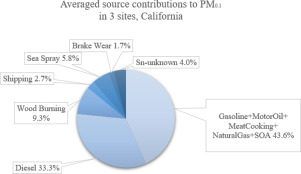当前位置:
X-MOL 学术
›
Sci. Total Environ.
›
论文详情
Our official English website, www.x-mol.net, welcomes your feedback! (Note: you will need to create a separate account there.)
Positive matrix factorization of ultrafine particle mass (PM0.1) at three sites in California.
Science of the Total Environment ( IF 9.8 ) Pub Date : 2020-01-23 , DOI: 10.1016/j.scitotenv.2020.136902 Wei Xue 1 , Jian Xue 1 , Amirhosein Mousavi 2 , Constantinos Sioutas 2 , Michael J Kleeman 1
Science of the Total Environment ( IF 9.8 ) Pub Date : 2020-01-23 , DOI: 10.1016/j.scitotenv.2020.136902 Wei Xue 1 , Jian Xue 1 , Amirhosein Mousavi 2 , Constantinos Sioutas 2 , Michael J Kleeman 1
Affiliation

|
Ultrafine particles (UFPs) are an emerging air quality concern because of their enhanced toxicity compared to larger airborne particles. This study aims to better understand source contributions to UFP mass (PM0.1) at multiples sites across California. Three-day average samples of PM0.1 collected over a full year at San Pablo, East Oakland, and Los Angeles were analyzed using Positive Matrix Factorization (PMF). Seven PM0.1 source-factors were identified at all locations: Factor1- Gasoline+Motor Oil+Meat Cooking+Natural Gas+SOA (31-53% PM0.1 mass), Factor 2- Diesel+Motor Oil (25-45% PM0.1 mass), Factor 3-Wood Burning (6-12% PM0.1 mass), Factor 4-Shipping and other heavy fuel oil combustion (2-3% PM0.1 mass), Factor 5-Sea Spray (4-8% PM0.1 mass), Factor 6-Sb Brake Wear (1-3% PM0.1 mass) and Factor 7-Sn - Unknown (1-7% PM0.1 mass). PM0.1 wood burning contributions were highest in the winter season when residential wood combustion was active. The monthly-averaged PM0.1 source apportionment results calculated by PMF are consistent with the PM0.1 source apportionment results calculated using Chemical Mass Balance (CMB) from the same sampling campaign. PMF distinguished Diesel+Motor Oil from Gasoline+Motor Oil+Meat Cooking+Natural Gas+SOA based on the species EC3 (a sub-fraction of elemental carbon that is volatilized and oxidized at temperatures between 700 and 775 °C), but PMF failed to further resolve the major sources of PM0.1 OC because unique tracers were not measured. PMF resolved "Shipping and other heavy fuel oil combustion" and Sea Spray sources based on inorganic tracers V and Br. The PMF factor rich in Sb very likely comes from brake wear associated with on-road vehicles and railway operations. The undefined Sn factor may be indicative of local industrial sources and traffic emission, but further research will be required to confirm this hypothesis. The PM0.1 source apportionment results contained in the current study further characterize the seasonal and spatial patterns of UFP concentrations in California.
中文翻译:

加利福尼亚州三个地点的超细颗粒质量(PM0.1)的正矩阵分解。
超细颗粒(UFP)由于与更大的机载颗粒相比具有更高的毒性而成为人们关注的空气质量问题。这项研究旨在更好地了解加利福尼亚州多个站点对UFP质量(PM0.1)的源贡献。使用正矩阵分解(PMF)分析了整整一年在圣巴勃罗,东奥克兰和洛杉矶收集的PM0.1的三天平均样本。在所有位置都确定了七个PM0.1来源因子:因子1-汽油+机油+肉类烹饪+天然气+ SOA(31-53%PM0.1质量),因子2-柴油+机油(25-45%) PM0.1质量),因子3木材燃烧(6-12%PM0.1质量),因子4运输和其他重质燃油燃烧(2-3%PM0.1质量),因子5海上喷雾(4 -8%PM0.1质量),因子6-Sb制动磨损(1-3%PM0.1质量)和因子7-Sn-未知(1-7%PM0.1质量)。PM0。在冬季,当住宅木材燃烧活跃时,木材燃烧贡献最高。PMF计算的每月平均PM0.1来源分配结果与使用同一采样活动的化学物质平衡(CMB)计算的PM0.1来源分配结果一致。PMF基于EC3物种(在700至775°C的温度下易挥发和氧化的元素碳的一部分)区分了柴油,机油,汽油,机油,肉类烹饪,天然气和SOA。进一步解决PM0.1 OC的主要来源,因为未测量独特的示踪剂。PMF解决了基于无机示踪剂V和Br的“运输和其他重质燃料油燃烧”和Sea Spray来源。富含Sb的PMF因子很可能来自与公路车辆和铁路运营相关的制动磨损。不确定的Sn因子可能表示当地的工业来源和交通排放,但是需要进一步的研究来证实这一假设。当前研究中包含的PM0.1源分配结果进一步表征了加利福尼亚州UFP浓度的季节和空间格局。
更新日期:2020-01-24
中文翻译:

加利福尼亚州三个地点的超细颗粒质量(PM0.1)的正矩阵分解。
超细颗粒(UFP)由于与更大的机载颗粒相比具有更高的毒性而成为人们关注的空气质量问题。这项研究旨在更好地了解加利福尼亚州多个站点对UFP质量(PM0.1)的源贡献。使用正矩阵分解(PMF)分析了整整一年在圣巴勃罗,东奥克兰和洛杉矶收集的PM0.1的三天平均样本。在所有位置都确定了七个PM0.1来源因子:因子1-汽油+机油+肉类烹饪+天然气+ SOA(31-53%PM0.1质量),因子2-柴油+机油(25-45%) PM0.1质量),因子3木材燃烧(6-12%PM0.1质量),因子4运输和其他重质燃油燃烧(2-3%PM0.1质量),因子5海上喷雾(4 -8%PM0.1质量),因子6-Sb制动磨损(1-3%PM0.1质量)和因子7-Sn-未知(1-7%PM0.1质量)。PM0。在冬季,当住宅木材燃烧活跃时,木材燃烧贡献最高。PMF计算的每月平均PM0.1来源分配结果与使用同一采样活动的化学物质平衡(CMB)计算的PM0.1来源分配结果一致。PMF基于EC3物种(在700至775°C的温度下易挥发和氧化的元素碳的一部分)区分了柴油,机油,汽油,机油,肉类烹饪,天然气和SOA。进一步解决PM0.1 OC的主要来源,因为未测量独特的示踪剂。PMF解决了基于无机示踪剂V和Br的“运输和其他重质燃料油燃烧”和Sea Spray来源。富含Sb的PMF因子很可能来自与公路车辆和铁路运营相关的制动磨损。不确定的Sn因子可能表示当地的工业来源和交通排放,但是需要进一步的研究来证实这一假设。当前研究中包含的PM0.1源分配结果进一步表征了加利福尼亚州UFP浓度的季节和空间格局。

























 京公网安备 11010802027423号
京公网安备 11010802027423号